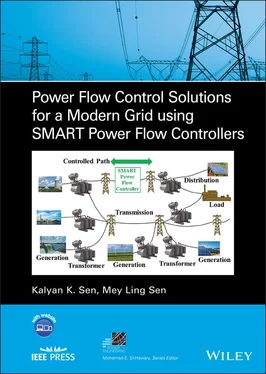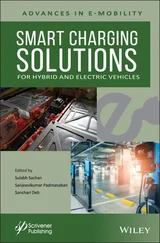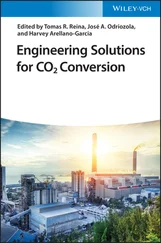Kalyan K. Sen - Power Flow Control Solutions for a Modern Grid Using SMART Power Flow Controllers
Здесь есть возможность читать онлайн «Kalyan K. Sen - Power Flow Control Solutions for a Modern Grid Using SMART Power Flow Controllers» — ознакомительный отрывок электронной книги совершенно бесплатно, а после прочтения отрывка купить полную версию. В некоторых случаях можно слушать аудио, скачать через торрент в формате fb2 и присутствует краткое содержание. Жанр: unrecognised, на английском языке. Описание произведения, (предисловие) а так же отзывы посетителей доступны на портале библиотеки ЛибКат.
- Название:Power Flow Control Solutions for a Modern Grid Using SMART Power Flow Controllers
- Автор:
- Жанр:
- Год:неизвестен
- ISBN:нет данных
- Рейтинг книги:5 / 5. Голосов: 1
-
Избранное:Добавить в избранное
- Отзывы:
-
Ваша оценка:
- 100
- 1
- 2
- 3
- 4
- 5
Power Flow Control Solutions for a Modern Grid Using SMART Power Flow Controllers: краткое содержание, описание и аннотация
Предлагаем к чтению аннотацию, описание, краткое содержание или предисловие (зависит от того, что написал сам автор книги «Power Flow Control Solutions for a Modern Grid Using SMART Power Flow Controllers»). Если вы не нашли необходимую информацию о книге — напишите в комментариях, мы постараемся отыскать её.
Power Flow Control Solutions for a Modern Grid using SMART Power Flow Controllers
Power Flow Control Solutions for a Modern Grid using SMART Power Flow Controllers
Power Flow Control Solutions for a Modern Grid Using SMART Power Flow Controllers — читать онлайн ознакомительный отрывок
Ниже представлен текст книги, разбитый по страницам. Система сохранения места последней прочитанной страницы, позволяет с удобством читать онлайн бесплатно книгу «Power Flow Control Solutions for a Modern Grid Using SMART Power Flow Controllers», без необходимости каждый раз заново искать на чём Вы остановились. Поставьте закладку, и сможете в любой момент перейти на страницу, на которой закончили чтение.
Интервал:
Закладка:
Power systems of today were designed based on central generating stations and transmission and distribution lines to get the energy to the loads. However, with land‐based and off‐shore wind plants and distributed and utility‐scale solar plants being connected to the grid, the old paradigm does not work since the geographic locations of the renewable resources do not in general coincide with the traditional generating plants. There is a need for the T&D systems to be revisited and modified/upgraded for the new power flow regimes. The line impedances that were tuned or optimized to serve certain flow patterns may now hinder delivery of the renewable energy to the desired destinations. The intermittent nature of the renewable energy sources brings additional challenges to system frequency and voltage control and to adopting the needed dynamic capability and the ability to control power flows bidirectionally at the right price. This can be mitigated with impedance regulation in strategically‐selected transmission corridors. Furthermore, in many localities there are no new right‐of‐ways (ROWs), and rebuilding is limited to existing ones. Even though rebuild could be inevitable, flow control may help in some scenarios and may be much more economical.
The key to a clean energy transition depends on the electric grid’s ability to generate and distribute renewable energy through the transmission and distribution system. The intermittency of supply and bidirectional flows, coupled with the remote locations of solar and wind projects, are challenging grid planners and operators. Even before we have reached large penetration of renewables, forecasters are factoring renewable curtailment as a major strategy to balance supply and demand, which adversely impacts the economics of the projects.
The concept of a SMART Power Flow Controller, developed in this book, is based on impedance management of the transmission line, which will be essential to (1) building the capacity to integrate and expand the use of clean distributed energy resources, (2) pursuing efficient asset utilization and reducing system losses, (3) facilitating greater transfer of clean energy from generation sites to load centers, and (4) improving grid reliability and resiliency. This technology can be customized, based on the required range and speed of operation, component non‐obsolescence, ease of relocation, and interoperability.
This book starts with the derivation of the fundamentals of power flow in an AC transmission line and develops various solutions that can be used to enhance power flow while reducing the losses in AC transmission lines. The book builds on the evolution of power flow controllers in AC transmission systems covering the theory, modeling, and various applications. The subject is treated from the working engineers’ point of view. After reading the appropriate parts of this book, students, teachers, and practicing engineers will be able to conduct studies of power system networks to mitigate their unique power flow problems.
The book’s unique contribution is that it
provides the basic theory and the step‐by‐step explanation of various power flow controllers;
offers modeling techniques that are essential to electric utilities when conducting the needed studies and analysis;
provides computer codes in the most widely‐used Electro‐Magnetic Transients Program (EMTP) formats;
describes a new class of power flow controllers, based on the transformers/Load Tap Changers (LTCs) technology, developed by the authors and named the Sen Transformer (ST).
It is important to emphasize that the ST offers the equivalent control features of two devices – Phase Angle Regulator (PAR) and Voltage Regulator (VR) – for almost the price of one. If one purchases a PAR, which offers the phase angle or active power flow control only, the ST offers the added voltage or reactive power flow control capability with perhaps a small additional cost. The low‐cost power flow control technology, such as ST, is of interest to utilities because of its simplicity, compared to power electronics inverter‐based Unified Power Flow Controller.
I believe that the Sens’ inventions are fundamental contributions toward the advancement of low‐cost electric power flow control technology. A simulation model of the ST has already been developed in PSS/E, the most widely used load flow software, and the report is given in Appendix C. As an application example exercising the PSS/E model, it was verified that the ST performed as the most suitable candidate for power flow enhancement in a segment of the Chilean network. Also, a distribution‐level Chinese demonstration of a 10‐kV unit of ST confirmed the anticipated performance of the ST.
The topic of power flow control is of great interest to many power engineering professionals, utility engineers, large power equipment manufacturers, university professors, and students. The specialty of the book is that it develops the modern power flow control theories from the basics and supplements the theory with relevant computer models using the most widely used simulation software – EMTP and PSS/E. This book expands upon what the authors had presented in their last book, titled Introduction to FACTS Controllers – Theory, Modeling, and Applications .
In summary, the subject of power flow control cannot be overstressed; it is a very important topic to the electric power industry and electric utilities, particularly in today’s environment. Due to the current need for integrating renewable energy sources into the grid reliably to reduce the carbon‐based generation, electric utilities are seriously considering all available technical solutions. This is a timely book that gives the reader clear instructions on how to model, design, build, and evaluate power flow controllers. It supplements nicely the very few existing books. I realize that this book is practical, hands‐on, and a true guide for the practicing engineers. The book gives significant amounts of detail in modeling and presentation that will be much appreciated by researchers/engineers in the field.
Since the 1990s, I have been interacting with Dr. Kalyan Sen on Flexible Alternating Current Transmission Systems (FACTS)‐related projects. As the Lead Simulation Engineer at Westinghouse, Dr. Sen developed the FACTS models, which were essential for performing the feasibility study of the Convertible Static Compensator (CSC) FACTS project before its installation at the New York Power Authority (NYPA) Marcy 345 kV substation in central NY.
I have read this book with great interest. It is a work of love, written by two spouses who spent their entire careers in developing a much‐needed power flow control technology that can help utilities worldwide to plan and operate their power grids. The specialty of the Sens’ book is that it is coauthored by an engineer who actually designed and commissioned a number of power electronics‐based FACTS controllers at Westinghouse since their inceptions in the 1990s. Therefore, the book includes a flavor of practical relevance. This book is going to aid the transformational change that is taking place in the electric utility industry worldwide.
White Plains, New York
Bruce B. Fardanesh Ph.D.,IEEE Life Fellow
Vice President, System Planning & Analysis
New York Power Authority
Nomenclature
βRelative phase angle of the series‐compensating voltage with respect to the sending‐end voltageδsPhase angle of the voltage at the sending end of a lineδrPhase angle of the voltage at the receiving end of a lineδPower angle (difference of phase angles of the voltages at the two ends of a line)δ′Modified power angle (difference of phase angles of the voltages at the two ends of a line after compensation)δ′lLowest modified power angleδ′hHighest modified power angleεLeast error of the calculated voltage and actually‐tapped voltage in the Sen TransformerθPhase‐locked loop (PLL) angleθIPhase angle of the line currentθVXPhase angle of the voltage across the line reactanceοDegreeφPower factor angleϕPhase angle between the voltage across the line reactance and the voltage difference between the sending and receiving endsωAngular frequencyψPhase‐shift angle of the modified sending‐end voltage with respect to the sending‐end voltageΩUnit of resistance, reactance, and impedancea1‐b1‐c1Series‐compensating windings in the A phase of STa2‐b2‐c2Series‐compensating windings in the B phase of STa3‐b3‐c3Series‐compensating windings in the C phase of STA‐B‐CExciter windings of STA1‐B1‐C1Shunt‐compensating windings in the A phase of STA2‐B2‐C2Shunt‐compensating windings in the B phase of STA3‐B3‐C3Shunt‐compensating windings in the C phase of STAAmpere (unit of current)ACAlternating CurrentANSIAmerican National Standards InstituteaprInstantaneous apparent power ratingAPRApparent Power RatingATCAvailable Transfer CapabilitybMultiplier of VXn from 0 to 1BPSBulk Power SystemBTB‐SSSCBack‐To‐Back SSSCBTB‐STATCOMBack‐To‐Back STATCOMBYPBRKBypass breakerCCapacitancecos(φ)Power factorcpCompensating points of the Sen TransformerCSCConvertible Static Compensatorcr, cs′, cseInterceptdDuty cycleDCDirect CurrentDCLSDC Link Switch EShunt‐ or series‐connected voltageEHVExtra High VoltageESElectronic SwitchFFarad (unit of capacitance)FACTSFlexible Alternating Current Transmission SystemsFCFixed CapacitorGaNGallium NitrideGHGGreen‐House GasGPFCGeneralized Power Flow ControllerGSTGeneralized Sen TransformerGTOGate‐Turn OffHHenry (unit of inductance)HVHigh VoltageHzHertz (unit of frequency)iInstantaneous current, such as line current (i), exciting current (iex), sending‐end current (is), source current (isrc), and so onILine current magnitude ILine currentIBRInverter‐Based ResourceIECInternational Electrotechnical CommissionIEEEInstitute of Electrical and Electronics Engineers I exExciter current through the primary winding of the Sen TransformerIPFCInterline Power Flow ControllerInNatural line current magnitudeIRImpedance Regulator I sCurrent at the sending end of the line I srcSource currentITCRCurrent through Thyristor‐Controlled ReactorkNumber of TCSC sectionskHzKilo Hertz (unit of frequency)kRFactor, representing the ratio of line resistance, R, when line current is I and the line resistance, Rn, when line current is In.LInductanceLTCLoad Tap ChangerLVLow VoltageMCMagnetic Circuitmr, ms′, mseSlopemsMillisecondMSTMultiline Sen TransformerMvarMega VAR (unit of reactive power)n(subscript) NaturalNCNormally‐ClosedNERCNorth American Electric Reliability CorporationNONormally‐OpenpThree‐phase instantaneous active powerPActive powerPARPhase Angle RegulatorPlinenPower loss in the natural or uncompensated linePlinkActive power on the common linkPrActive power at the receiving end of the linePrhHighest active power at the receiving end of the linePrlLowest active power at the receiving end of the linePrnNatural active power at the receiving end of the linePsActive power at the sending end of the linePseExchanged active power by a Series UnitPshExchanged active power by a Shunt UnitPsnNatural active power at the sending end of the linePsrcActive power at the sourcePs′Active power at the modified sending end of the linePFCPower Flow ControllerPOCPoint of Connection to the utilityPSTPhase‐Shifting TransformerpuPer unitqThree‐phase instantaneous quadrature powerQQuality factorQReactive powerQBQuadrature BoosterQlinenReactive power absorbed by the natural or uncompensated lineQlinkReactive power on the common linkQrReactive power at the receiving end of the lineQrhHighest reactive power at the receiving end of the lineQrlLowest reactive power at the receiving end of the lineQrnNatural reactive power at the receiving end of the lineQsReactive power at the sending end of the lineQseExchanged reactive power by a Series UnitQshExchanged reactive power by a Shunt UnitQsnNatural reactive power at the sending end of the lineQsrcReactive power at the sourceQs′Reactive power at the modified sending end of the linerkVoltage error at a possible kth operating point in the Sen TransformerRLine resistanceR′Resistance of a section of a lineReffEffective line resistanceROMRough‐Order MagnitudeRMSRoot Mean SquareRRReactance RegulatorRseSeries‐compensating resistanceRshShunt‐compensating resistancesSecondSApparent powerSiCSilicon CarbideSMARTSpecific, Measurable, Attainable, Relevant, and Time‐boundSPFCSMART Power Flow ControllerSrApparent power at the receiving end of the lineSsApparent power at the sending end of the line se(subscript) Series‐exchanged, i.e. cse, mse, Pse, Rse, Xse , Qse, ZseSseExchanged apparent power by a Series Unit sh(subscript) Shunt‐exchanged, i.e. Psh, Rsh, Xsh , Qsh, ZshSshExchanged apparent power by a Shunt UnitSSSCStatic Synchronous Series CompensatorSs′Apparent power at the modified sending end of the lineSTSen TransformerSTATCOMSTATic synchronous COMpensatorSVCStatic Var CompensatorSynConSynchronous CondensertTimeTCRThyristor‐Controlled ReactorTHDTotal Harmonic DistortionTNATransients Network AnalyzerTSCThyristor‐Switched CapacitorTSRThyristor‐Switched ReactorTTCTransmission Transfer CapabilityUHVUltra High VoltageUPFCUnified Power Flow ControllerUPSUninterruptible Power SupplyvInstantaneous voltageVPhase voltage magnitude VPhasor voltageVVolt (unit of voltage)vavolt‐ampere (unit of instantaneous apparent power)VAVolt‐Ampere (unit of apparent power)VARVolt‐Ampere Reactive (unit of reactive power)VRVoltage RegulatorVRTVoltage‐Regulating TransformerVSCVoltage‐Sourced Converter V dVoltage across the compensating resistance V dqVoltage across the compensating impedance V qVoltage across the compensating reactance V rVoltage at the receiving end of the line V sVoltage at the sending end of the line V s′Voltage at the modified sending end of the line V s′hHighest voltage at the modified sending end of the line V s′lLowest voltage at the modified sending end of the line V s′sSeries‐compensating voltage V RVoltage across the line resistance V RnNatural voltage across the line resistance V R,XVoltage across the line impedance  V Rn,XnNatural voltage across the line impedance
V Rn,XnNatural voltage across the line impedance  V XVoltage across the line reactance V XnNatural voltage across the line reactanceWWatt (unit of active power)WECCWestern Electricity Coordinating CouncilXLine reactance (total)X′CCapacitive reactance of a section of a lineXeffEffective line reactanceX′LInductive reactance of a section of a lineXseSeries‐compensating reactanceXshShunt‐compensating reactanceZseSeries‐compensating impedanceZshShunt‐compensating impedance
V XVoltage across the line reactance V XnNatural voltage across the line reactanceWWatt (unit of active power)WECCWestern Electricity Coordinating CouncilXLine reactance (total)X′CCapacitive reactance of a section of a lineXeffEffective line reactanceX′LInductive reactance of a section of a lineXseSeries‐compensating reactanceXshShunt‐compensating reactanceZseSeries‐compensating impedanceZshShunt‐compensating impedance
Интервал:
Закладка:
Похожие книги на «Power Flow Control Solutions for a Modern Grid Using SMART Power Flow Controllers»
Представляем Вашему вниманию похожие книги на «Power Flow Control Solutions for a Modern Grid Using SMART Power Flow Controllers» списком для выбора. Мы отобрали схожую по названию и смыслу литературу в надежде предоставить читателям больше вариантов отыскать новые, интересные, ещё непрочитанные произведения.
Обсуждение, отзывы о книге «Power Flow Control Solutions for a Modern Grid Using SMART Power Flow Controllers» и просто собственные мнения читателей. Оставьте ваши комментарии, напишите, что Вы думаете о произведении, его смысле или главных героях. Укажите что конкретно понравилось, а что нет, и почему Вы так считаете.












